
|
People / Klaus Bandel
Klaus Bandel Homepage (contains a complete list of his publications) Klaus Bandel's Stromboidea work that resulted in publications: His special interest is the formation and the morpholgy of the early development of the shell. He is also interested in radula and ecology of Stromboidea. Bandel, K. (1974)
Bandel, K. (1975)
Bandel, K. (1976)
Bandel, K. (1979)
Bandel, K. (1984)
Bandel, K. & Wedler, E. (1987)
Bandel, K. & Hemleben, C. (1987)
Bandel, K. (1993)
Bandel, K. & Riedel, F., (1994)
Bandel, K., Riedel, F. & Weikert, H. (1997)
Kiel, s. & Bandel, K. (1999)
Bandel, K. & Stinnesbeck, W. (2000)
Kiel, S. & Bandel, K. (2002)
Kiel, S. & Bandel, K. (2004)
Bandel & Dockery
The relations within Stromboidea turned out to be complex since several protoconchs from Jurassic and Cretaceous species are known (see Gründel, Kaim). At the moment Klaus Bandel is working on material from the Cretacious and the Tertiary in comparison with recent larval shells from the Red Sea. Pictures from Klaus Bandel's work: 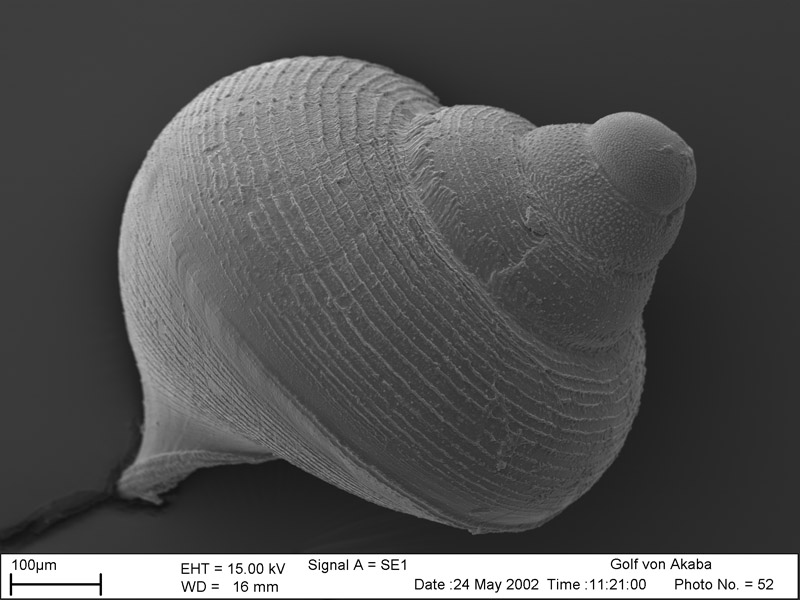 Gibberulus gibberulus (Linnaues, 1758); Protoconch; Aqaba, Gulf of Aqaba, Red Sea, Jordan; Coll. Klaus Bandel 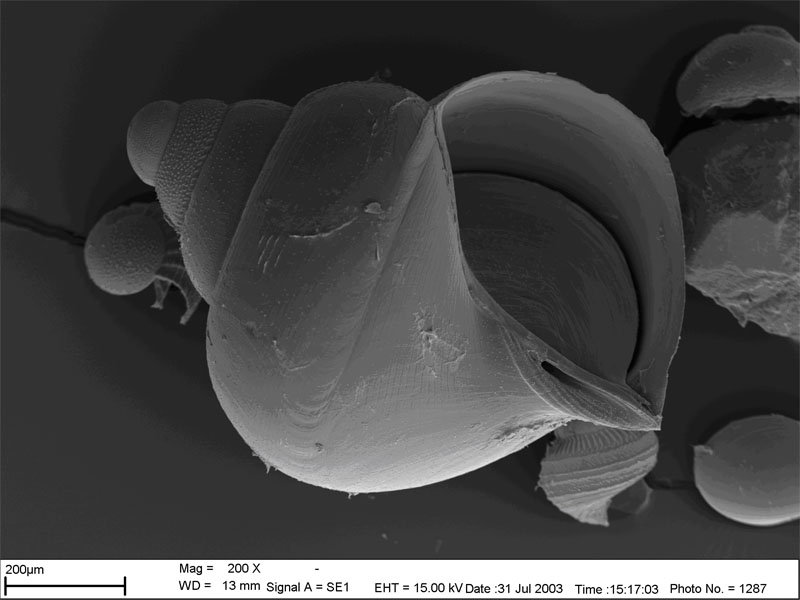 Fully grown larva of Gibberulus gibberulus (Linnaeus, 1758); Protoconch; Aqaba, Gulf of Aqaba, Red Sea, Jordan; Coll. Klaus Bandel The larval shell of Gibberulus gibberulus consists 4.5 whorls with shell width of almost 1 mm and a height of 1.1 mm. The embryonic shell is 0.16 mm wide and is ornamented with complex rows of fused granules. The first larval whorl is densely covered by granules. The transition to the second larval whorl is characterized by the onset of faint spiral lines and decrease of granular ornamentation. Spiral lines become the dominant sculpture of the two youngest larval whorls. The aperture is almost oval in outline with a distinct siphonal notch. The operculum seals the aperture tightly, and has a thorn-like anterior spine that fits in the siphonal notch. The nucleus of the operculum lies close to the anterior (basal) part of the columella and shows remains of spiral growth, whereas later growth increments are concentric. The larva swims with a six-lobed velum. Each velar lobe is almost twice as long as the conch. The larval conchs have a spherical, smooth appearance, and a more-or-less transparent shell. The larva carries the shell in such a way that the head with tentacles and eyes point in swimming direction and long narrow foot with operculum is held in behind. In the mantle cavity a large ciliated organ is seen representing the gill or osphradium. (Text by Klaus Bandel) 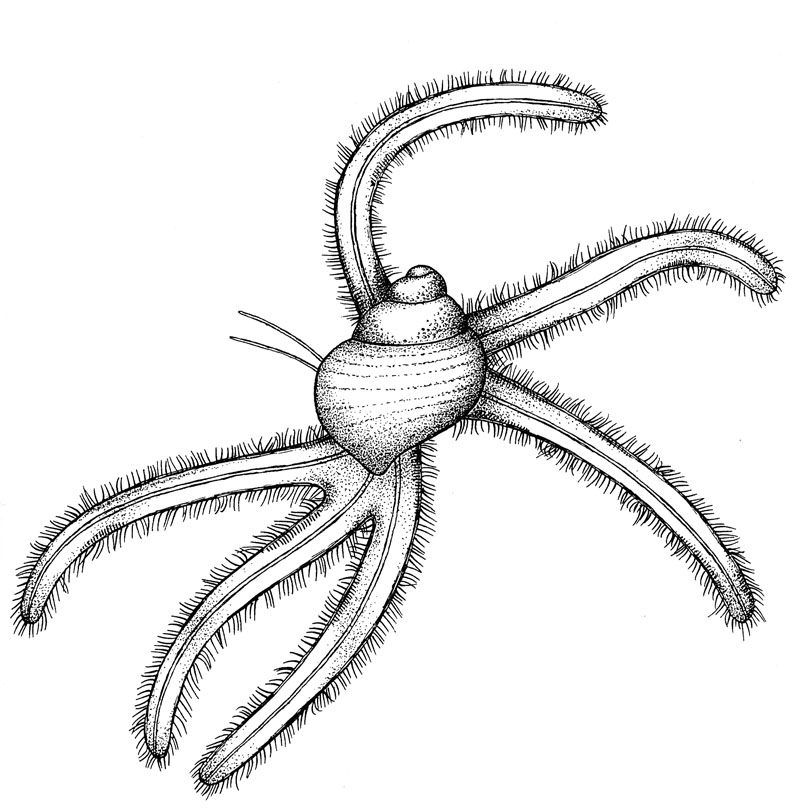 Drawing of Gibberulus gibberulus larva by Klaus Bandel 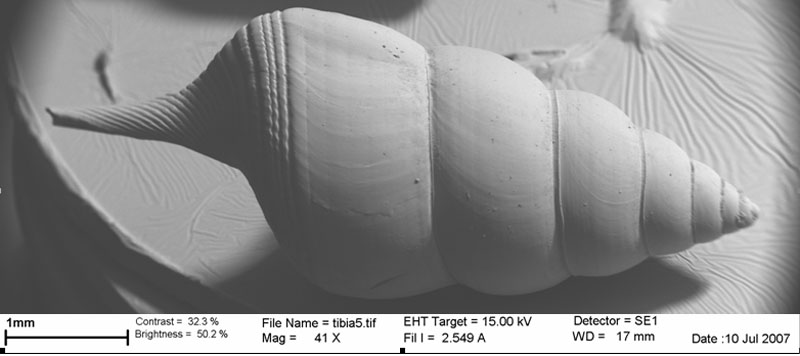 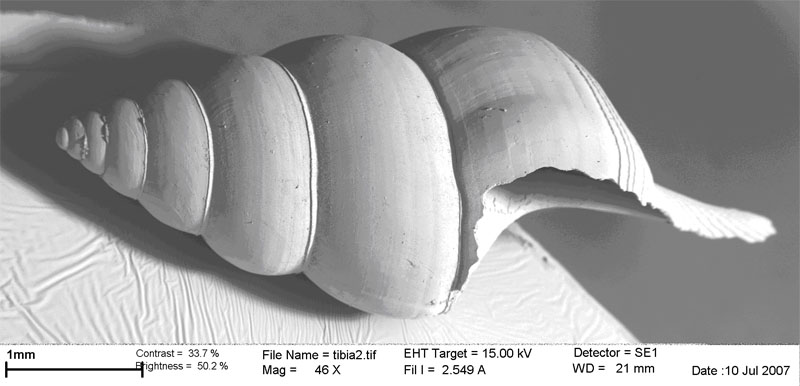 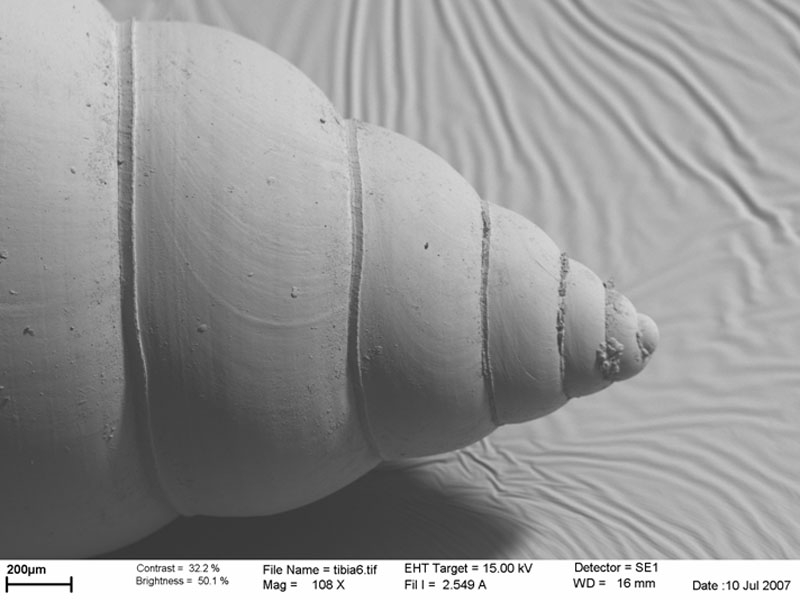 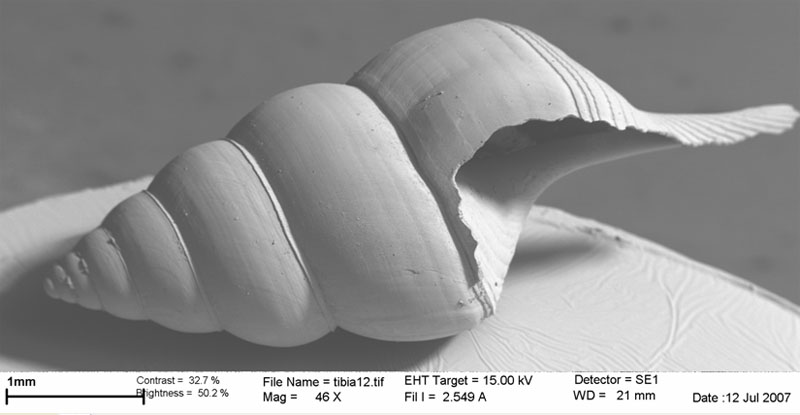 Protoconchs of Sulcogladius powisii; Coll. Klaus Bandel 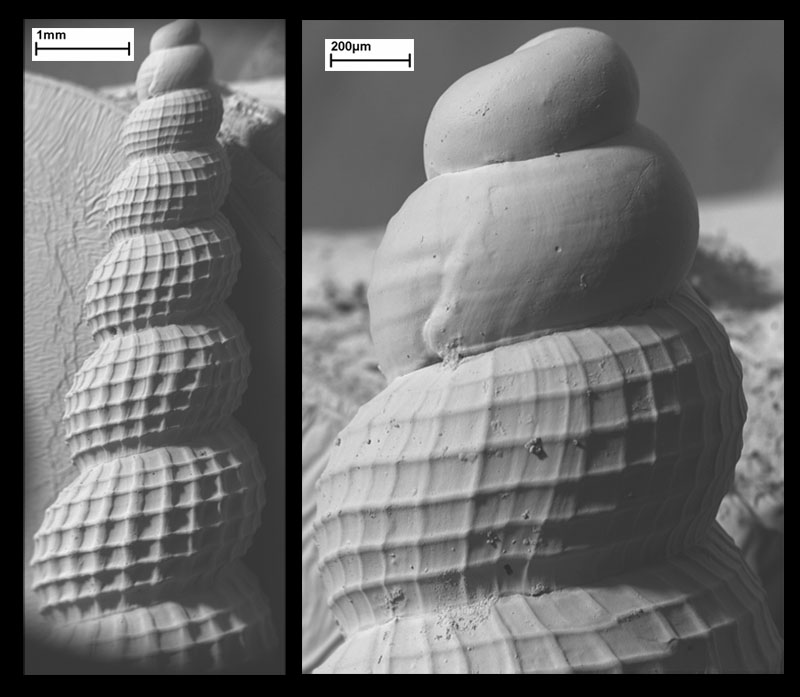 Tibia fusus (Linnaeus, 1758); Protoconch; Cebu Island, Central Visayas Region, Philippines; Coll. Klaus Bandel 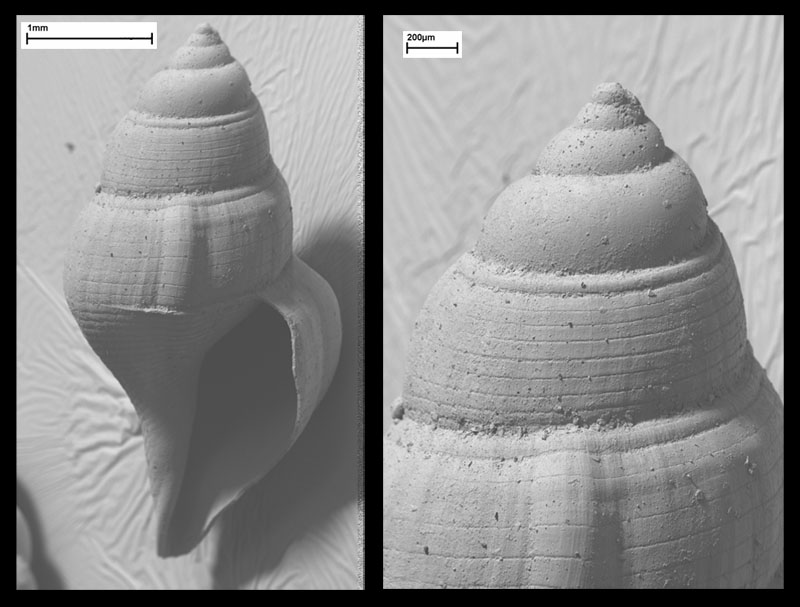 Laevistrombus canarium (Linnaeus, 1758); Protoconch; Coll. Klaus Bandel Texts by Klaus Bandel in this Wiki:
Some notes on the ontogeny, ecology and shell of Strombus gigas Linnaeus, 1758, the Queen Conch from the Caribbean Sea by Klaus Bandel This short rundown on the life history of Strombus gigas is based partly on own observations and confirmed and expanded by the intensive studies on culturing the species by DAVIS (2005). Some references from the literature are included. About the species many informations including illustrations of shell can be obtained from various sources in the internet, for example Eddie Hardy. The large shell of Strombus gigas is characterized by its large and flaring outer lip and the rich shades of pink, yellow and orange in the aperture (ABBOTT 1974). Periostracum is thick and flakes of from dried shells. The large shell is over 20 cm high, may be even up to 35 cm high. It gets heavy with age. The outer lip is wide, flared and thickened, sometimes with undulating margin in front and with a frontal sinus, the stromboid notch. A wide open and short siphon canal is developed. Through it and the stromboid notch the animal stretches its eyes when not buried in the sand. The posterior end of the flaring outer lip is attached to the spire on the shoulder of the last whorl next to a spine bearing corner. A wide low sinus forms the apical margin of the outer lip. Often this part has a bump on its outside, where it connects to the last rounded node on the body whorl. The seven whorls of the spire before the last have a corner on which a row of low pointed spines is aligned. Other than Turbinella angulata (LIGHTFOOT, 1766), Strombus gigas is the largest gastropod in the area of Santa Marta in the shallow Caribbean Sea (BANDEL & WEDLER 1987). In the shallow sea grass beds of Florida, the Bahamas and Bermuda the queen conch is even the largest gastropod (CLENCH & ABBOTT 1941, ABBOTT 1974, RANDALL 1964). Juveniles have a thin fragile outer lip and prefer very shallow lagoonal areas with soft substrate and dense turtle grass in which they can hide. Due to the culture of individuals it is well known what time is needed by them to grow to a size in which the adult aperture forms. To turn into a mature individual that can reproduce Strombus gigas has to live three to four years. It is ready to reproduce only after the outer lip has fully flared (DAVIS 2005). Large and fully grown individuals move to deeper water and prefer sea grass bottoms in 1.5 to 5 of depth in the bays near Santa Marta. Old shells are commonly strongly encrusted with all types of sessile organisms, including heavy corals. Such heavy overgrowth on the shell characterize individuals which live near the reef and on reef debris. Where the bottom is soft old individuals still bury themselves totally in the sand when resting. Due to this repeated process of burying the outer shell surface slowly becomes eroded by the sand and this is compensated for by deposition of shell material to the inner surface of the shell. In very old individuals the shell has become thickened from within and corroded from the outside resulting in a small and heavy individual which is known as Strombus samba CLENCH, 1937. It is assumed that individuals of Strombus gigas may be able to live for up to 30 years. Adult individuals usually stay away from the surf, except when spawning. They move into the breaker zone and deposit their egg masses of up to halve-a million eggs within the oxygen rich water just below tide line (BANDEL 1976). The embryos which develop within their round individual egg case hatch after four days (ROBERTSON 1959). Sexes are separate and in natural population males are a little smaller than females, and both are present in about the same number (DAVIS 2005). First copulation in Strombus gigas with sexually mature individuals occurs when the animals are about four years old. The thin sticky strand of eggs is covered with sand grains, and egg masses form large sausage- like bodies (DAVIS 2005, fig.3). The veligers hatch with two lobed velum and actively swim in the water column for about three weeks. Here they feed on phytoplankton. They metamorphose into benthic animals in response to signals which they receive from the sea grass habitat. The egg masses are deposited on or just below the surface of the sediment. A whole population of a single bay near Santa Marta was encountered in the process at the same time of the year (BANDEL 1976). Copulation and spawning usually occurs when water is warmest (DAVIS 2005). The egg capsules are interconnected to a gelatinous string of about 1 mm in thickness (BANDEL 1976, fig.1), which in case of Strombus gigas is several meters long and tangled to a heap (D’ASARO 1965). Each capsule contains one embryo, and from one spawn about 300000 veligers to as many as 750000 hatch. The larva of Strombus gigas hatches as two lobed veliger, after four days in the Plankton has four lobes, and after about 8 days is has 6 lobes (DAVIS 2005, fig.7). Metamorphosis occurs when the fully grown protoconch is about 1.2 mm high and the larva has been in the Plankton for at least 21 days. After 8-10 days a six-lobed velum is present when the shell is about 0.7 mm in size. This velum remains similar until the larva is ready for metamorphosis with about 1.2 mm large shell. At this stage the eyes have migrated outward, the tentacles are of equal length, the pigment of the foot changes, the ctenidium (gill) becomes functional and the buccal mass has developed. In the larva ready to change to benthic life the buccal mass with the radula is present, while the veliger feeds on algal cells that have been collected by the cilia of the velum, and food reaches the stomach by way of ribbons of cilia. When the veliger has metamorphosed the velar lobes are lost. The foot which had only been used to manipulate the operculum is now used for crawling, and the small snail searches for food with the proboscis. In about half a year the young will have grown up to a size of about 20 mm, but growth can be much less to only about 5 mm (in culture) (SHAWL & DAVIS 2004). Larvae of Strombus gigas closely resemble those of Strombus gibberulus LINNAEUS, 1758 (Strombus gibberulus albus MÖRCH, 1850) and Strombus fasciatus BORN, 1778, both of which are very common in the Red Sea (BANDEL et al, 1997 Fig.2; Fig.18, A-D). Also regarding the steps of the transitions from larval to adult organs during metamorphosis resemble each other. In case of Strombus gigas, after feeding on phytoplankton for about three weeks (up to eight weeks, DAVIS 2005) during larval existence metamorphosis to bottom life results in the 1.2 mm large benthic animal that hides in sandy bottom and algal thickets, usually within the sea-grass meadows. In Santa Marta small juveniles were found hidden in algal thickets and in shallow sea grass meadows often within the intertidal zone of a lagoon. DAVIS (2005) found that the life usually spans for about 6 years and sometimes up to five times longer. Juveniles have a thin apertural margin and elongate conical shape. Their hidden life ends with the formation of the final aperture. After that individuals may remain for a longer time on the surface of the bottom substrate and can have heavy overgrowths. Mature Strombus gigas individuals prefer the well illuminated zone in shallow water, where they graze diatoms and other organisms on algae. The food of Strombus gigas consist predominantly on minute algae. When they feed quite a lot of sand is swallowed, which results in the production of many feces with characteristic shape (BANDEL 1976). They are usually in association with "turtle grass" (Zosteraceae). Locomotion of adults is characterized by leaps, while juveniles move with the usual gliding of their foot as is the usual case among other benthic gastropods. Grown Strombus gigas moves by anchoring the foot in the ground with the pointed operculum and than pulling the body up and forward in one jump. Than disengaging the anchorage and forming a new one in the direction of wanted movement and so on. The eye and the tentacle belonging to it peering through the siphonal notch is larger than the one extended through the stromboid notch to the right of it. During locomotion the tentacle and eye is held above the apertural edge and searches through the water. When the snail is attacked by a star fish of a carnivorous gastropod such as Fasciolaria it will shoot out the saw edged operculum and swipe it across the shell to loosen the offending grip. When placed on the sand on its back the snail brings out the narrow and muscular foot, anchors the claw-like operculum in the bottom sediment and turns itself over in a second (ABBOTT 1960, BANDEL & WEDLER 1987). Live animals with their eyes protruding from below the shell are also documented by internet pages, such as of R. Dirscherl.
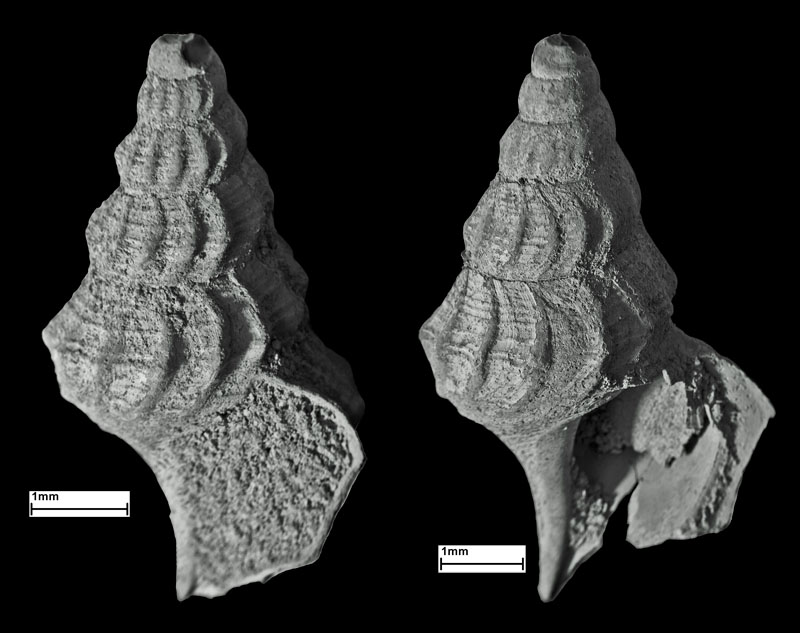 Aporrhais tridactylus (Braun, 1850); juvenile specimen; Schleichsand, Rupelian, lower Oligocene; Kuhhimmel, Gumbsheim, Rhineland-Palatinate State, Germany; Coll. Ulrich Wieneke; Photo Klaus Bandel 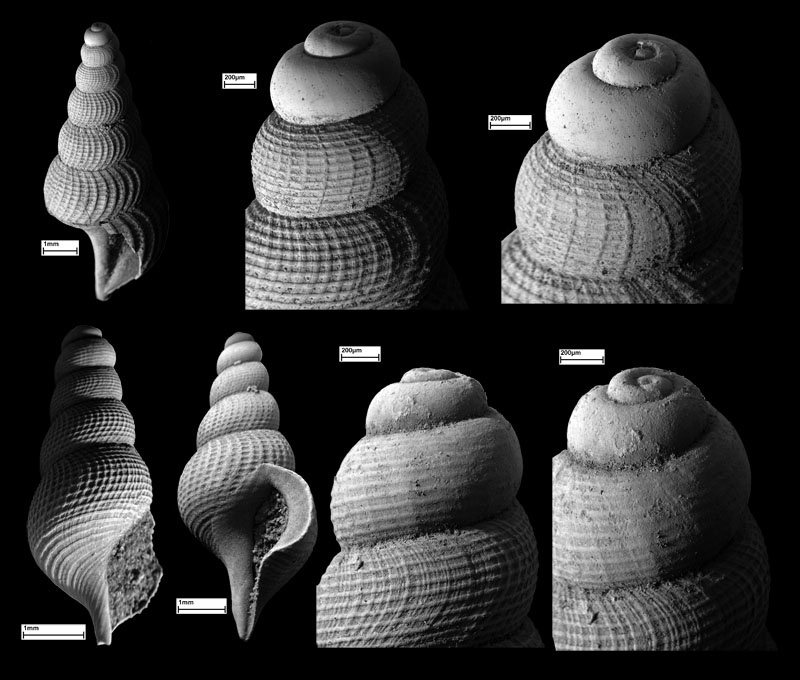 Aporrhais megapolitana Beyrich, 1854; juvenile specimen; "Sternberger Gestein", Chattian, upper Oligocene; Kobrow, Mecklenburg-West Pomerania State, Germany; Coll. Ulrich Wieneke; Photo Klaus Bandel 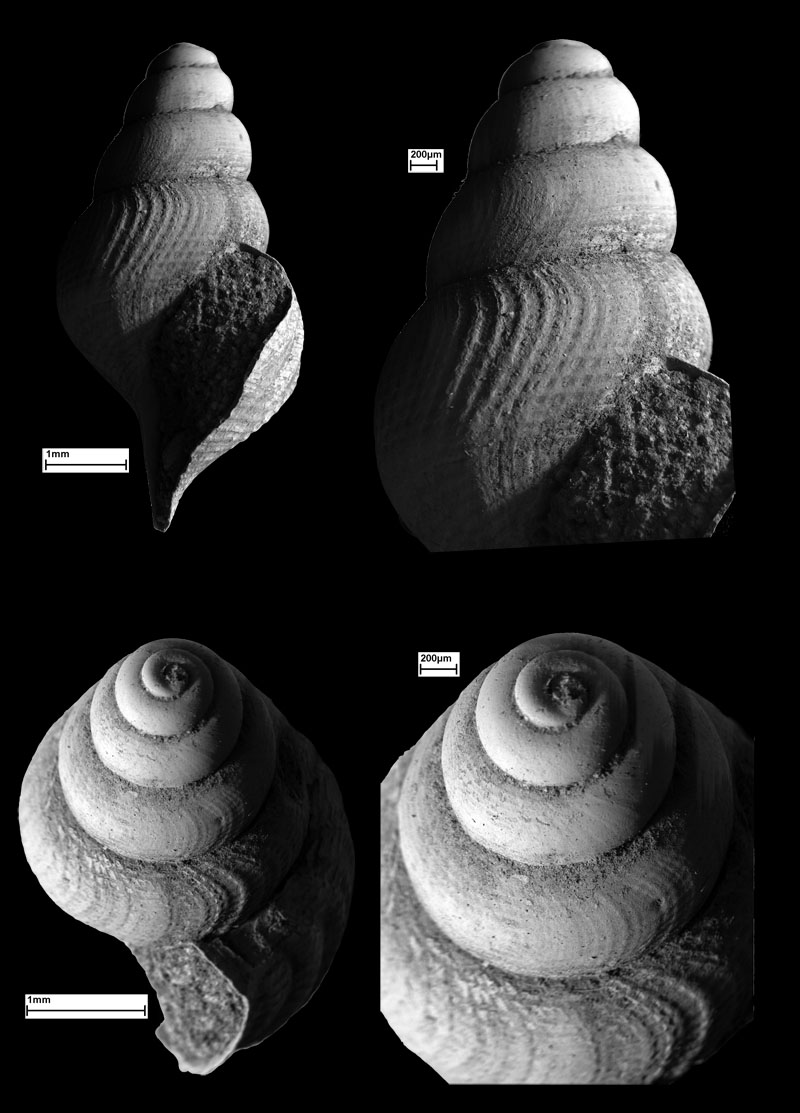 Aporrhais speciosa (von Schlotheim, 1820); juvenile specimen; "Sternberger Gestein", Chattian, upper Oligocene; Kobrow, Mecklenburg-West Pomerania State, Germany; Coll. Ulrich Wieneke; Photo Klaus Bandel 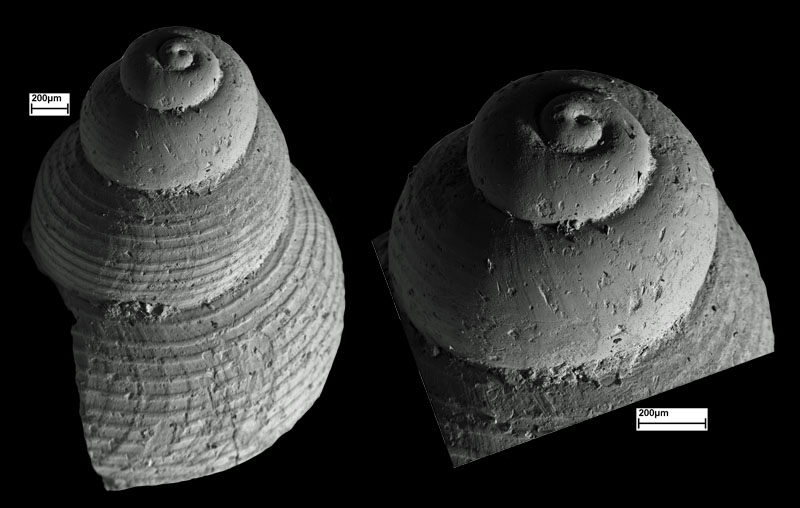 Aporrhais dingdenensis Marquet, Grigis & Landau, 2002; Protoconch; Glimmerton, Reinbeckian, Miocene; Tongrube Wessling, Woltrup, Lower Saxony State, Germany; Coll. Klaus Bandel 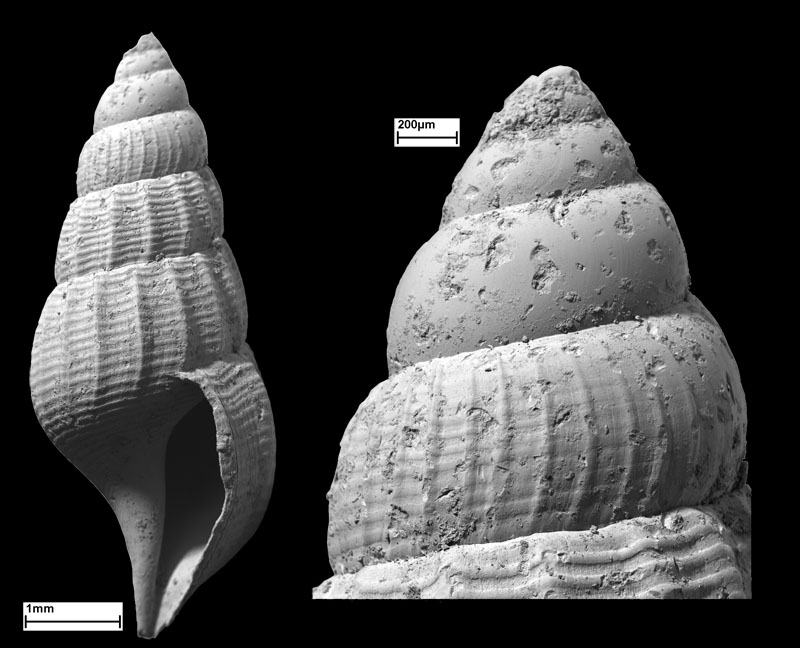 Strombolaria interrupta (Deshayes, 1865); Protoconch; Cuisian, Ypresian, lower Eocene; Aizy-Jouy, Aisne Department, France; Coll. Ulrich Wieneke; Photo Klaus Bandel 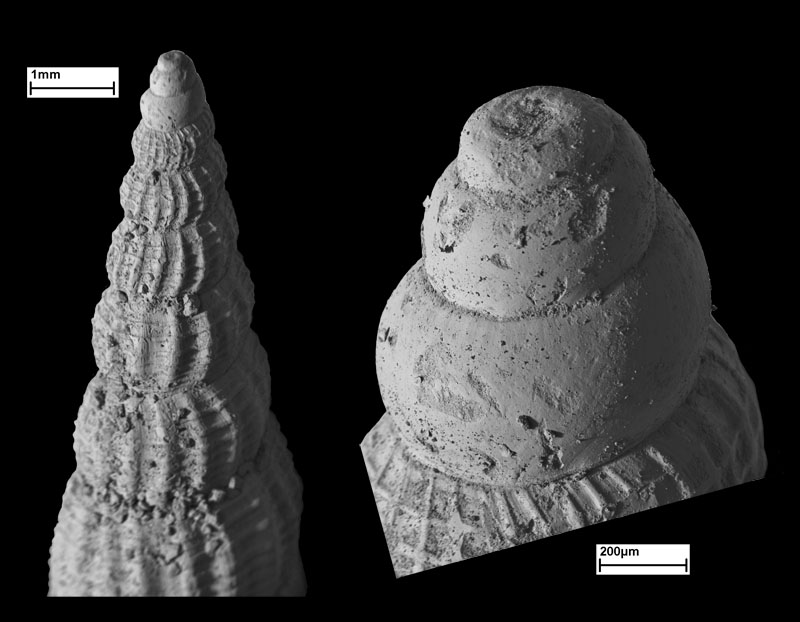 Tibia cf. dentata (Grateloup, 1827); Aquitanian, lower Miocene; Vives Quarry, Saint-Martin-d'Oney, Landes Department, France; Ex-coll. Ulrich Wieneke; Coll. Klaus Bandel 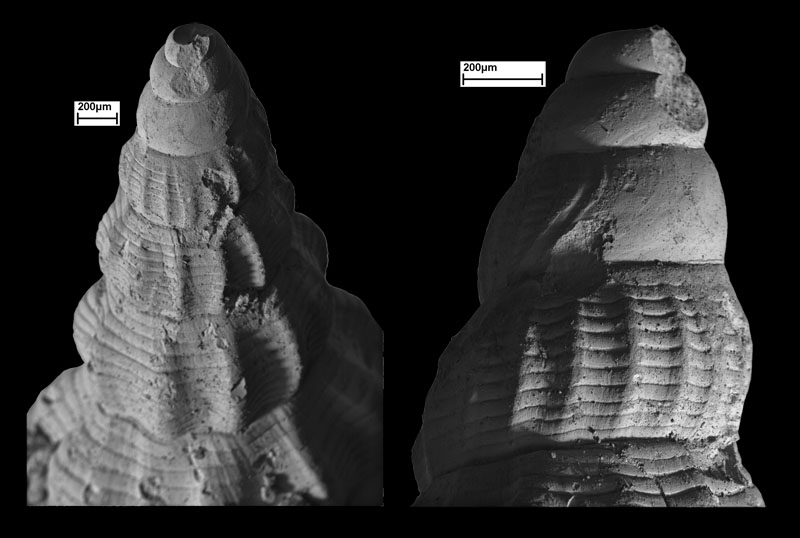 Varicospira decussatus (Basterot, 1825); Badenian (Langhian), middle Miocene; Varpalota, Veszprém County, Western Hungary; Ex-coll Ulrich Wieneke; Coll. Klaus Bandel Internet Links:
|